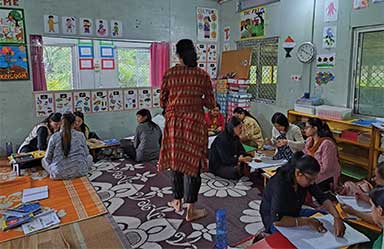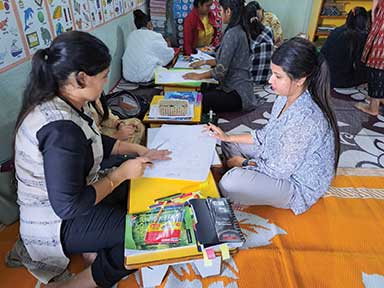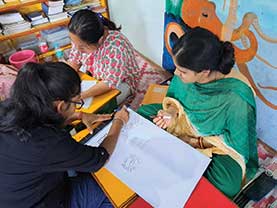Nabanita Deshmukh
Swarna Mathur is a teacher in a government school near Ranchi. She is 45 years old and despite her long experience in teaching, Swarna looks glum. There are about 20 teachers working in the school but none whom Swarna can call ‘a friend’. Frequent bickering, gossiping, bad-mouthing, aggressive competitiveness create an unhealthy atmosphere in the staff room. No wonder Swarna feels drained at the end of the day and wonders why her colleagues are so narrow-minded and pushy.

Swarna’s story may sound harsh but it is not uncommon. A lot has been written about bonding between teachers and students or about principals and the staff yet the relationship between teachers and how it affects the school environment is seldom mentioned.
It is a known fact that effective communication between teachers brings about positive changes in the classroom. Teachers, supported by colleagues, manage students better and help them interact positively with their peers. Furthermore, the right kind of bonding between teachers develops self-confidence and changes attitudes vis a vis learning and teaching. Unfortunately, one hears more teacher-stories on unhealthy competition, aggressive bullying and self-centeredness than about collaboration and team work.
How can teachers build harmonious relationships that would make them confident, happy and competent? Here are a few insights.
Types of relationships
The nature of relationships among adults in a school, particularly teachers can be broadly divided into four types: parallel, adversial, associative and cooperative. Interestingly, these relation types are similar to the way toddlers play and learn and by applying these concepts to adult behaviour one can better understand how teachers interact with one other.

Parallel play
Toddlers in pre-schools learn by interacting or not interacting with their peers. Try and visualize two small girls playing at the opposite ends of a sandpit. One uses a small spade and pail to collect sand while the other has a sack and a spoon. Neither wants to share her playthings or even talk. Each one glances at the other and imitates her friend’s actions but is totally absorbed in the play. This type of play or work in isolation is called parallel play.
Parallel play can be applied to teachers as well. In many schools, teachers work/teach in isolation without sharing their skills or knowledge with others. The consequences of this type of self-absorbed or self-centred work are dire. Teachers continue making the same mistakes, there is no feedback given by the others, no sharing of expertise either; hence no reflection. In such a stagnating scenario, teachers do not grow or progress and tend to feel cloistered and frustrated.
Adversial searches
Adversial searches are game-playing techniques used in AI (Artificial Intelligence). Agents (players) are surrounded by a competitive environment. A complex goal or target is given to the agents who ferociously compete with one another to win the game.

Likewise, in relationships between teachers, aggressive competitiveness sometimes enhances a teacher’s performance but most often diminishes it. Competition among teachers takes many forms such as refusal to share one’s knowledge, deliberate shows of hostility, unjust or hurtful criticism, humiliation and a host of other toxic behavioural patterns that prevent the creation of a strong teacher community in schools.
Associative play
Fortunately, not all teacher relationships are hostile or self-centred. There are instances where teachers help one another in non-academic chores, such as offering a ride when a colleague has missed the bus or picking up groceries when a friend is unwell. Yet to build strong bonds, these generous acts are helpful but never enough. To explain this concept further, one needs to observe toddlers who are playing together but are not creating anything together. These children have building blocks with them but each one builds something different. Everyone talks with one another but each child builds a structure independently. This type of activity is called associative play.
Similarly, teachers when they help each other in non-academic chores are close but for the bonds to become stronger another type of relationship has to set in.
Collaborative play
A teacher in a primary classroom has a goal in mind – the construction of a royal palace with Lego pieces. She assigns different tasks to her students such as building of walls, gates, turrets, bridges, moats, lawns, stables, etc. Once the children complete their tasks, the teacher combines the Lego units and lo! A spectacular palace emerges! The children are thrilled! Each child feels that he/she has contributed something valuable to the construction of the palace and a sense of ownership for the project develops.
In the same way, if the head of an institution encourages teachers to collaborate and work towards a common goal by assigning different tasks to each teacher and then collates it to create a comprehensive project, a sense of ownership develops and the school environment greatly improves. For example, to create a ‘green school’, each teacher is given a task such as ensuring that the surrounding is clean, students switch off the lights and fans while getting out of classrooms, children get healthy dishes from home instead of junk food to eat during recess and do not throw away plastic items but rather recycle them, etc.

It is certainly important to begin such collaborative activities but the real challenge is to continue doing them so that both teachers and students derive the maximum benefit. Heads of schools need to organize different kinds of collaborative engagements where teachers learn to show solidarity, empathy and support towards their colleagues but how to make this happen? Here are a few tips:
- Teachers observe each other’s classes and come up with feedback and suggestions.
- Teachers take turns to present to their colleagues a classroom practice that has either worked or failed.
- Teachers take part in online discussions and share ideas and teaching practices with educators and instructors.
- Teachers help colleagues in classroom chores whenever possible such as managing unruly students, fetching books from libraries, creating TLMs (Teaching Learning Materials) together, etc.
- Teachers meet like-minded colleagues at convenient times to read and discuss educational articles or books especially when meeting a large group of peers becomes difficult.
- Teachers abstain from unjustly criticizing or reporting colleagues’ teaching styles and behaviour. They stick to relevant discussions regarding students’ assessments, performances, learning styles, remedial teaching, classroom management, etc.
- Teachers attend workshops on reflective practices where they are encouraged to improve their own perceptions on teaching and also develop empathy towards their peers and pupils.
The quality of bonding between teachers has a great impact not only on their personalities, attitudes and teaching styles but also on students’ accomplishments and satisfaction. For that matter, in any school whether large or small, rural or urban, teachers need to forge mature relationships with their peers based on mutual respect, trust and sharing. Only then can a harmonious, caring and dynamic teacher community emerge, one that would enhance teachers’ motivation, well-being and performance for the years ahead.
The author is a teacher, a teacher educator and a writer of children’s stories and poems. She can be reached at deshmukh.nitu@gmail.com.
